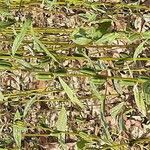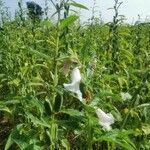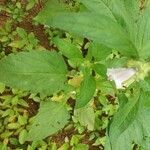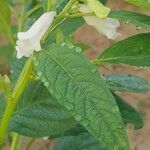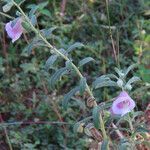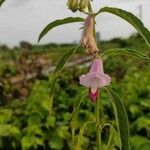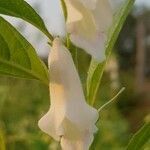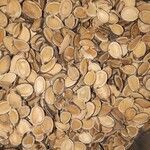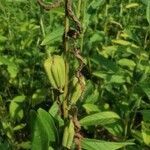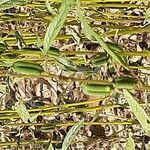Erect annual herb, 10-120 cm high; stem simple or branched, obtusely quadrangular, finely pubescent to glabrescent, more or less glandular. Leaves very variable in shape, usually heteromorphic, opposite or alternate; the inferior long-petiolate (petiole 3-11 cm long), lanceolate to ovate, 3-lobed, 3-partite or 3-foliate, 4-20 x 2-10 cm, cuneate or obtuse at the base, acute at the apex, margins often serrate; superior leaves more shortly petiolate (petiole 3-5 cm long), narrowed, oblong-lanceolate to linear-lanceolate, 0.5-2.5 cm broad, usually entire and narrowly cuneate at the base; all leaves thinly pubescent and more or less glandular, glabrescent. Flowers white, pink or mauve-pink with darker markings. Calyx persistent. Corolla 1.5-3.3 cm long. Capsule narrowly oblong in lateral view, 4-sulcate, rounded at the base, 1.5-3.0 x 0.6-0.7 cm; beak broad and short; walls of the capsule often not smooth, but covered with horizontal stripes (impressions of the seeds). Seeds more or less horizontal, not winged but with an inconspicuous double fringe; testa smooth, rarely slightly venose, black, brown or white when mature.
Erect, fetid, glandular pubescent, annual herb to 2 m tall, somewhat branched; stems 4-angled. Leaves opposite below, often alternate above, variable in shape, entire, serrate, palmately lobed or nearly compound, 8-15 cm long, 6-10 cm wide, pubescent above and below and with copious 4-celled short-stalked glands beneath, the petioles ca. 5 cm long, often pilose. Inflorescence a single flower or 2-3 flowers in the upper leaf axils; pedicels 1-2 cm long with 2 yellow or black basal nectaries. Flowers white, rose or purple, mostly maculate; calyx 6-8 mm long, deeply 5 lobed, the lobes similar, acute or acuminate; corolla campanulate, basally minutely saccate, slightly 2-lipped, pubescent outside and with 1-4 celled glands; anthers pale yellow with a short white or brownish beak; ovary pilose, erect, brown or purple, grooved, with 4 rounded angles, the style slender, gla-brous. Fruit apically dehiscent, to 3 cm long, oblong, glabrate to hirsute; seeds smooth or minutely rugose, to 3 mm long.
A small upright plant. It is an annual plant. It is erect and much branched. It grows 1-2 m tall. The stem is stout and 4 sided. It is furrowed along its length. It is densely covered with glandular hairs. The leaves are fine and downy. They vary in shape. The lower leaves have long stalks and are spear shaped often with lobes or a toothed edge. The leaf stalks are 3-11 cm long. The leaf blade is 4-20 cm long by 2-10 cm wide. Upper leaves are narrow and oblong. They are 0.5-2.5 cm wide. The flowers are pink and white. They occur in the axils of upper leaves. They occur either on their own or in groups or 2 or 3. They can be white, pink, purplish and with yellow spots and stripes. The fruit can be smooth or rough and there are 2 chambers in the capsule. The fruit are brown or purple. They are oblong and deeply grooved. The seeds are small and oval. They are 3 mm by 1.5 mm and vary in colour from white, yellow, grey, red, brown or black. The fully ripe pods burst open.
Herbs annual, erect, to 1.2 m tall. Stems branched or unbranched, 4-angled, finely pubescent to glabrescent. Leaves opposite or alternate; petiole 3-11 cm on lower leaves; leaf blade lanceolate to ovate, variously 3-parted, 4-20 X 2-10 cm; upper stem leaves oblong to linear-lanceolate, 0.5-2.5 cm wide, base cuneate, margin entire. Flowers white, pink, or mauve-pink with darker markings. Calyx persistent. Corolla 1.5-3.3 cm. Capsule narrowly oblong, rounded at base, 1.5-3 cm X 6-7 mm; beak broad, short. Seeds horizontally arranged, double fringe conspicuous; testa white, brown, or black when ripe, smooth. 2n = 26*.
Leaves very variable in shape, usually heteromorphic, opposite or alternate; the inferior long-petiolate (petiole 3–11 cm. long), lanceolate to ovate, 3-lobed, 3–partite or 3-foliate, 4–20 x 2–10 cm., cuneate or obtuse at the base, acute at the apex, margins often serrate; superior leaves more shortly petiolate (petiole 3–5 cm. long), narrowed, oblong-lanceolate to linear-lanceolate, 0.5–2.5 cm. broad, usually entire and narrowly cuneate at the base; all leaves thinly pubescent and more or less glandular, glabrescent.
Erect annual to 1.5 m, evidently to inconspicuously hairy; lvs lanceolate to ovate, entire or in part coarsely toothed; fls pink or yellowish to white, 2–3 cm, on short, ascending-erect pedicels; fr 2–3 cm, roundly 4-angled; seeds oily, aromatic; 2n=26. Native probably of India, but unknown in the wild; long in cult., and occasionally found in our range as a casual escape.
Annual herb, 0.1-1.2 m high. Leaves variable; inferior leaves entire or lobed to digitate, opposite or alternate. Bracts of extrafloral nectaries conspicuous. Inferior lip of flower not prominent. Seeds not winged but with an inconspicuous double fringe, testa smooth or slightly venose. Flowers white, pink or mauve-pink with darker markings.
Capsule narrowly oblong in lateral view, 4-sulcate, rounded at the base, 1.5–3.0 x 0.6–0.7 cm.; beak broad and short; walls of the capsule often not smooth, but covered with horizontal stripes (impressions of the seeds) (TAB. 23 fig. 6).
Seeds more or less horizontal, not winged but with an inconspicuous double fringe (TAB. 25 fig. 6); testa smooth, rarely slightly venose, black, brown or white when mature.
Erect annual herb, 10–120 cm. high; stem simple or branched, obtusely quadrangular, finely pubescent to glabrescent, more or less glandular.
Flowers white, pink or mauve-pink with darker markings.
Flowers whitish or pink and purple-tinged and spotted
Erect, simple or branched, herb, 1-6 ft. high
Corolla 1.5–3.3 cm. long.
Calyx persistent.
Cultivated.
